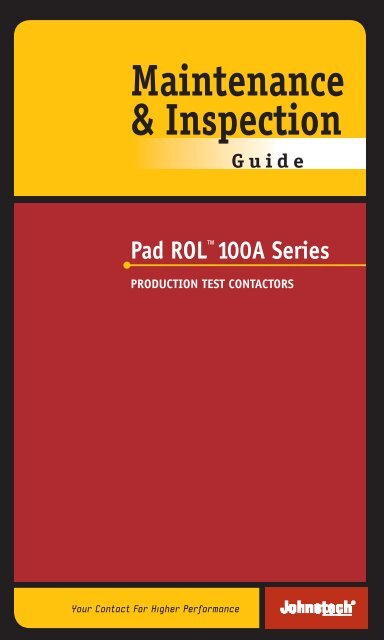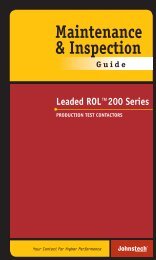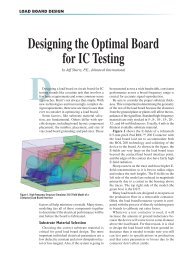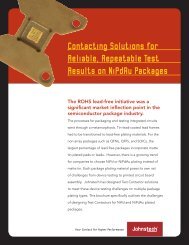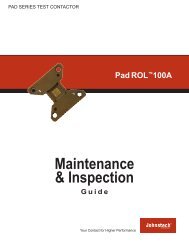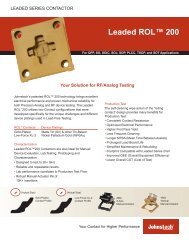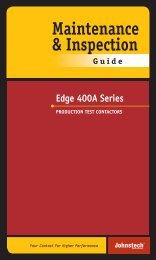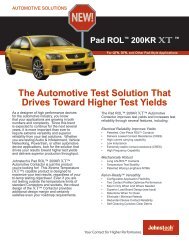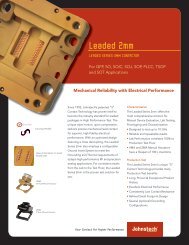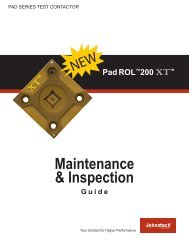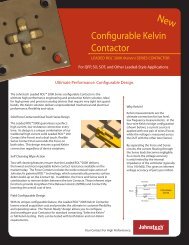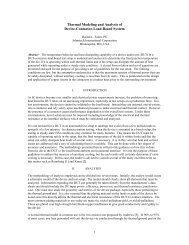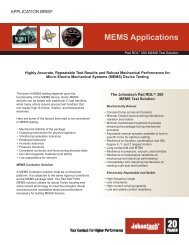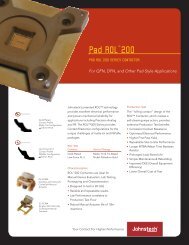Pad ROLâ¢100A Series - Johnstech
Pad ROLâ¢100A Series - Johnstech
Pad ROLâ¢100A Series - Johnstech
Create successful ePaper yourself
Turn your PDF publications into a flip-book with our unique Google optimized e-Paper software.
Maintenance<br />
& Inspection<br />
Guide<br />
<strong>Pad</strong> ROL 100A <strong>Series</strong><br />
PRODUCTION TEST CONTACTORS<br />
Your Contact For Higher Performance<br />
www.johnstech.com<br />
©2010 <strong>Johnstech</strong> International Corporation<br />
All rights reserved.<br />
1
<strong>Pad</strong> ROL100A<br />
<strong>Series</strong><br />
About <strong>Johnstech</strong><br />
Since 1992, <strong>Johnstech</strong> International Corporation,<br />
headquartered in Minneapolis, MN, has been a<br />
leading provider of interconnect solutions for<br />
semiconductor manufacturers who want higher<br />
first-pass yields and lower overall cost of test.<br />
<strong>Johnstech</strong>’s high performance Test Contactors are<br />
available in <strong>Pad</strong>, Leaded and Edge packages and<br />
are based on patented technology that provides<br />
superior electrical and mechanical performance.<br />
<strong>Johnstech</strong> also partners with Handler, Tester and<br />
Load Board manufacturers to ensure appropriate<br />
interfaces. With offices in the United States<br />
and Singapore; Field Service offices in California,<br />
Singapore & Taiwan; and representation in China,<br />
Israel, Japan, Korea, Southeast Asia (Malaysia,<br />
Philippines, Singapore, Thailand) and Taiwan,<br />
<strong>Johnstech</strong> is proud to provide worldwide service<br />
and support.<br />
(Please refer to the back cover for addresses and<br />
phone numbers or go to our website at www.<br />
johnstech.com.)<br />
www.johnstech.com<br />
©2010 <strong>Johnstech</strong> International Corporation<br />
All rights reserved.<br />
2
Table of Contents<br />
Standard Product Information . . . . . . . . . . . 4<br />
Contactor Component Information . . . . . . . . 5<br />
Contactor Identification Information . . . . . . 6<br />
Contactor Verification Information. . . . . . . . 7<br />
Recommended Tools . . . . . . . . . . . . . . . . . . 8<br />
Cleaning and Maintenance Frequency . . . . . . 9<br />
Pre-Maintenance Troubleshooting . . . . .10-11<br />
Load Board & Contactor Inspection . . . . . . 12<br />
Load Board Inspection.. . . . . . . . . . . . . . . . . . . . . . 12<br />
Contactor Inspection .. . . . . . . . . . . . . . . . . . . . . . . 12<br />
Housing, Elastomer & Contact Inspection. 13<br />
Housing Inspection .. . . . . . . . . . . . . . . . . . . . . . . . 13<br />
Elastomer Inspection.. . . . . . . . . . . . . . . . . . . . . . . 13<br />
Contact Inspection. . . . . . . . . . . . . . . . . . . . . . . . . 13<br />
Oxide Buildup.. . . . . . . . . . . . . . . . . . . . . . . . . . . . 13<br />
Contactor Removal & Installation ........14<br />
Contact & Elastomer Removal . . . . . . . . . . 15<br />
Contactor Cleaning . . . . . . . . . . . . . . . .16-18<br />
Light Cleaning. . . . . . . . . . . . . . . . . . . . . . . . . . . . 16<br />
Ultrasonic Cleaning .. . . . . . . . . . . . . . . . . . . . . . . . 17<br />
Elastomer Installation . . . . . . . . . . . . . . . 19<br />
Contact Installation . . . . . . . . . . . . . . . . . 20<br />
Installation Verification . . . . . . . . . . . . . . 21<br />
Grounding Information . . . . . . . . . . . . .22-25<br />
Grounding Options . . . . . . . . . . . . . . . . . . . . . . . . . 22<br />
Ground Insert Removal.. . . . . . . . . . . . . . . . . . . . . . 23<br />
Ground Insert Installation (New RCI) .. . . . . . . . . . . . 24<br />
Ground Insert Installation (Flex-Fit RCI).. . . . . . . . . . 25<br />
<strong>Pad</strong> ROL100A<br />
<strong>Series</strong><br />
For questions about anything contained in<br />
this Maintenance & Inspection Guide,<br />
contact your local <strong>Johnstech</strong> representative.<br />
If you are experiencing a technical problem<br />
or issue, fill out the online Tech Help Form at:<br />
www.johnstechhelp.com<br />
(All forms will be responded to within two business days.)<br />
OR contact the nearest Field Service Office.<br />
(Turn to the back cover for addresses/phone numbers.)<br />
www.johnstech.com<br />
©2010 <strong>Johnstech</strong> International Corporation<br />
All rights reserved.<br />
3
<strong>Pad</strong> ROL100A<br />
<strong>Series</strong><br />
Gold-Plated Fine Tip Contact<br />
Matte Tin Configuration<br />
≥ 0.50 mm Pitch<br />
(Contact # 153164-0001)<br />
Gold-Plated Full Tip Contact<br />
Matte Tin Configuration<br />
0.4mm Pitch<br />
(Contact # 152144-0001)<br />
Clear Elastomer<br />
Low-Force XL-2 Fine Tip<br />
Contact<br />
NiPdAu Configuration<br />
≥ 0.5mm pitch<br />
(Contact #161805-0001)<br />
Clear Elastomer<br />
Low-Force XL-2 Fine Tip Contact<br />
NiPdAu Configuration<br />
0.4mm pitch<br />
(Contact #161717-0001)<br />
www.johnstech.com<br />
©2010 <strong>Johnstech</strong> International Corporation<br />
All rights reserved.<br />
4<br />
Standard Product Information<br />
Electrical Specifications<br />
(Measured using Gold-Plated and Low-Force XL Contact<br />
Configurations, shown on left, for Matte Tin and NiPdAu packages.)<br />
Matte Tin NiPdAu<br />
Electrical Length: .. . . . . . . . . . . . . . . . . 1.10 mm.. . . . . . . . 1.14mm<br />
Inductance: .. . . . . . . . . . . . . . . . . . Self: 0.23 nH.. . . . . . . 0.37 mm<br />
.. . . . . . . . . . . . . . . . Mutual: 0.14 nH.. . . . . . . . 0.15 nH<br />
Capacitance: . . . . . . . . . . . . . . . . .Ground: 0.16 pF......... 0.08 pF<br />
.. . . . . . . . . . . . . . . . Mutual: 0.05 pF.. . . . . . . . 0.03 pF<br />
S21 Insertion Loss (G-S-G): . . . . . . . .-1 dB@40 GHz. .. -1 dB @ 40 GHz<br />
S11 Return Loss (G-S-G):.. . . . . . . -20 dB@14.5 GHz. -20 dB @ 18.3 GHz<br />
S41 Crosstalk (G-S-S-G): .. . . . . . . . -20 dB@32 GHz. -20 dB @ 33.5 GHz<br />
Average Contact DC Resistance:.. . . . . . . . 50 mOhms. ......25 mOhms<br />
Current Carrying Capability: . . . . . . . . . . . . . . . 4 A . .......... 4 A<br />
Current Leakage:.. . . . . . . . . . . . . . .
Contactor Components<br />
Methodology<br />
Device Under Test<br />
Contact<br />
Inner/Front Elastomer<br />
Outer/Back Elastomer<br />
Load Board<br />
<strong>Pad</strong> ROL100A<br />
<strong>Series</strong><br />
Note: The Green/Red<br />
Elastomer and Gold-Plated<br />
Contact (153164) for matte<br />
tin packages are shown in the<br />
illustrations throughout this<br />
document. For the NiPdAu<br />
package configuration, refer<br />
to page 4 for the correct<br />
Contact and Elastomer configuration.<br />
Standard Parts<br />
Most <strong>Johnstech</strong> Contactors<br />
have four standard parts<br />
that comprise the Contactor<br />
assembly:<br />
· Housing<br />
· Contacts<br />
· Elastomers<br />
· Alignment Plate*<br />
Contactor Components<br />
Double-Latch Vertically Compliant<br />
Manual Actuator (DL-VCMA)**<br />
Alignment Plate<br />
A Manual Actuator is available<br />
for short-run testing and<br />
characterization.<br />
*An Alignment Plate is included<br />
with the Contactor<br />
for all designs utilizing an<br />
Alignment Plate during<br />
automated test operation.<br />
All other designs include an<br />
Alignment Plate as part of<br />
the Manual Actuator assembly.<br />
Leadbackers and Alignment<br />
Plates work as matched<br />
sets; changing either one<br />
may require changing both<br />
components.<br />
Fully-Assembled Contactor<br />
Housing<br />
**A Single-Latch Vertically<br />
Compliant Manual Actuator<br />
(SL-VCMA), pictured here, is<br />
also offered for select <strong>Pad</strong><br />
ROL100A Housing sizes.<br />
Acrylic Mounting Plate<br />
www.johnstech.com<br />
©2010 <strong>Johnstech</strong> International Corporation<br />
All rights reserved.<br />
5
<strong>Pad</strong> ROL100A<br />
<strong>Series</strong><br />
Identification<br />
Each <strong>Johnstech</strong> Contactor<br />
will have as much information<br />
as space allows. The<br />
identification system is designed<br />
to provide you with<br />
the technical information<br />
you need to identify the<br />
Contactor and its Design<br />
Data Sheet (example shown<br />
on the facing page).<br />
Contactor Identification<br />
Sample Contactor, Load Board Side Up<br />
9. Device Body 1. Manufacturer 6. Assembly 7. Device 8. Device<br />
Size (mm) Type Count Type<br />
5. Design Number<br />
10. Pitch (mm)<br />
3. Manufacturing<br />
Date Code<br />
Here is how to read the<br />
different data fields on the<br />
Contactors:<br />
1. JTI- identifies <strong>Johnstech</strong><br />
International as<br />
the manufacturer<br />
2. Serial Number<br />
3. Manufacturing Date<br />
Code (see tables at right)<br />
4. Perimeter Contact Width<br />
(in inches)<br />
5. Design Number<br />
For Custom Orders:<br />
1234-YYZZ<br />
YY = Contactor<br />
Technology Code<br />
A1 = ROL100A<br />
02 = ROL200<br />
ZZ = Configuration<br />
(or design iteration)<br />
Number<br />
For SelecTest® Order:<br />
6XXX-8XXXXX<br />
6XXX = Design Number<br />
8XXXXX = Configuration<br />
Number<br />
6. Assembly Type<br />
TS: Test Socket<br />
MA: Manual Actuator<br />
7. Device perimeter pad<br />
count<br />
8. Device Type<br />
9. Device Body size (mm)<br />
10. Device <strong>Pad</strong> Pitch (mm)<br />
11. Part Number (will appear<br />
only if Contactor is<br />
a SelecTest® order)<br />
www.johnstech.com<br />
©2010 <strong>Johnstech</strong> International Corporation<br />
All rights reserved.<br />
6<br />
Date Code Reference<br />
Week<br />
Week<br />
Letter Number Letter Number<br />
A 1 AA 27<br />
B 2 AB 28<br />
C 3 AC 29<br />
D 4 AD 30<br />
E 5 AE 31<br />
F 6 AF 32<br />
G 7 AG 33<br />
H 8 AH 34<br />
I 9 AI 35<br />
J 10 AJ 36<br />
K 11 AK 37<br />
L 12 AL 38<br />
M 13 AM 39<br />
N 14 AN 40<br />
O 15 AO 41<br />
P 16 AP 42<br />
Q 17 AQ 43<br />
R 18 AR 44<br />
S 19 AS 45<br />
T 20 AT 46<br />
U 21 AU 47<br />
V 22 AV 48<br />
W 23 AW 49<br />
X 24 AX 50<br />
Y 25 AY 51<br />
Z 26 AZ 52<br />
Date Code Examples:<br />
SN123456BK B = Week 2 K = 2001<br />
SN654321AAN AA = Week 27 N = 2004<br />
11. Part Number<br />
2. Serial Number<br />
4. Perimeter<br />
Contact Width<br />
Letter Year<br />
A 1991<br />
B 1992<br />
C 1993<br />
D 1994<br />
E 1995<br />
F 1996<br />
G 1997<br />
H 1998<br />
I 1999<br />
J 2000<br />
K 2001<br />
L 2002<br />
M 2003<br />
N 2004<br />
O 2005<br />
P 2006<br />
Q 2007<br />
R 2008<br />
S 2009<br />
T 2010<br />
U 2011<br />
V 2012
Contactor Configuration Verification<br />
Verify the Alignment Plate<br />
Example of Alignment Plate.<br />
Check the Alignment Plate Part<br />
Number (in red box) against the<br />
Part Number on the Design Data<br />
Sheet (shown below) to ensure it<br />
is the correct one.<br />
Example of Design Data Sheet<br />
Example of another Alignment<br />
Plate for the same Housing,<br />
with the opening size called out.<br />
Check the Part Number (in red<br />
box) against Design Data Sheet<br />
(below) to ensure it is correct.<br />
<strong>Pad</strong> ROL100A<br />
<strong>Series</strong><br />
Design Data Sheet<br />
The Design Data Sheet contains<br />
Contactor Specifications<br />
on Load Board layout,<br />
contact compressed height,<br />
Alignment Plate opening size<br />
and other information necessary<br />
for setup and troubleshooting.<br />
Refer to it to verify<br />
you are using the correct:<br />
· Alignment Plate (for manual<br />
vs. automated testing<br />
and for opening-to-device<br />
body size)<br />
· Contacts (refer to part<br />
number and thickness)<br />
· Elastomer Configuration<br />
· Load Board Layout<br />
Alignment Plate<br />
Verification<br />
Refer to the Design Data<br />
Sheet to ensure the proper<br />
Alignment Plate is being<br />
used. Different package<br />
vendors and Handlers require<br />
different Alignment<br />
Plates. The Design Data<br />
Sheet will specify which<br />
one is right for which application,<br />
as well as any<br />
special engraving to assist<br />
with identification.<br />
The Design Data Sheet may be a multiple-page document. Make sure<br />
the Part Numbers (in the red boxes) match up.<br />
www.johnstech.com<br />
©2010 <strong>Johnstech</strong> International Corporation<br />
All rights reserved.<br />
7
<strong>Pad</strong> ROL100A<br />
<strong>Series</strong><br />
Recommended Tools<br />
(in order at right)<br />
CAUTION: Avoid touching<br />
the Device- and Load<br />
Board-interface surfaces<br />
of the Contacts with<br />
metal tools. Scratches<br />
on these areas may<br />
degrade performance.<br />
Recommended Tools<br />
Screwdriver with Allen-Head Bits— for fastening the<br />
Contactor to the Load Board<br />
10X Eye Loupe— for magnified inspection of Contactor,<br />
Elastomers and Contacts<br />
Elastomer Tool— for use in Elastomer Installation as well as<br />
prying Alignment Plate from Contactor<br />
Fine-Tip Non-Metallic Tweezers— for handling Contacts and<br />
Elastomers<br />
Scalpel— for marking Elastomer lengths<br />
Micro Scissors— for cutting Elastomers to length<br />
Probe Tool— for use in Elastomer Installation<br />
Fiberglass Brush and Replacement Tips— recommended for<br />
cleaning the Contacts (If fiberglass brushes are not allowed<br />
on the test floor, although not optimum, nylon brushes can be<br />
substituted.)<br />
EXTRAS:<br />
Finger Cots— recommended to prevent contaminating Contactor<br />
components with skin oils<br />
Protective Eye wear— recommended to protect technicians<br />
from Test Floor/Contactor components, Compressed Air and other<br />
chemicals<br />
<strong>Johnstech</strong>’s Maintenance & Inspection Kit<br />
<strong>Johnstech</strong>’s Maintenance & Inspection Kit contains many of<br />
the tools needed for maintenance and inspection and are designed<br />
especially for <strong>Johnstech</strong> high performance Contactors.<br />
Contact your <strong>Johnstech</strong> representative for more information.<br />
www.johnstech.com<br />
©2010 <strong>Johnstech</strong> International Corporation<br />
All rights reserved.<br />
8<br />
Maintenance Kit Part Numbers—<br />
with torque screwdriver: 706449<br />
without torque screwdriver: 706448
Cleaning & Maintenance Frequency<br />
Determining Frequency<br />
Due to a wide range of variables (like those listed below),<br />
each Test Floor must determine their optimal cleaning and<br />
maintenance intervals through effective use of statistical<br />
process control. By carefully monitoring and recording yield<br />
rates and following good test floor troubleshooting procedures,<br />
you will be able to clearly differentiate between<br />
interface vs. maintenance problems and an effective maintenance<br />
cleaning cycle can be established to match the needs of<br />
each Test Floor. Contact your <strong>Johnstech</strong> representative or Field<br />
Service for further information or help.<br />
<strong>Pad</strong> ROL100A<br />
<strong>Series</strong><br />
Handler Design and Setup<br />
Handlers have a variety of test plane configurations, device<br />
transportation methods, plunge mechanisms and accessories.<br />
Each handler has its own unique attributes. Handler set-ups<br />
that are not optimized can increase the required maintenance<br />
frequency by contributing to premature Contactor and Elastomer<br />
wear and Oxide Build-up on the Contacts. By working<br />
with <strong>Johnstech</strong> and your handler supplier, you can optimize<br />
handler/contactor performance to minimize downtime.<br />
Correct Contact Compressed Height<br />
Incorrect contact compressed height reduces the effectiveness<br />
of the Contact’s self-cleaning wipe and may cause increased<br />
oxide build-up and/or decreased contact life and load board<br />
pad life. It may also adversely affect Elastomer life by creating<br />
tears, cuts or Compression Set (permanent deformation). See<br />
examples on Page 13. The contact compressed height for each<br />
Contactor is specified on the Design Data Sheet.<br />
Package and Device Plating Variations<br />
Variations in packages can affect your maintenance schedule.<br />
Different package vendors, or even different device lots, may<br />
have varying amounts of Mold Flash that can decrease wear on<br />
the Contactor and alter device placement. Also, the method<br />
used for plating the device can vary the rate of debris buildup,<br />
and therefore varying the maintenance interval.<br />
Contaminants<br />
Accumulation of contaminants on the contactor and/or load<br />
board (such as Oxides and Mold Flash) will contribute to continuity<br />
and/or parametric failures during the test process.<br />
General Test Floor Maintenance Activities<br />
The frequency of Handler maintenance procedures also affects<br />
Contactor cleaning. For example, how often the Handler and<br />
handler test areas are blown free and/or vacuumed of debris<br />
impacts the effectiveness of the Contactor. Contactors exposed<br />
to increased levels of foreign debris are likely to require<br />
more frequent maintenance and cleaning.<br />
www.johnstech.com<br />
©2010 <strong>Johnstech</strong> International Corporation<br />
All rights reserved.<br />
9
<strong>Pad</strong> ROL100A<br />
<strong>Series</strong><br />
If experiencing problems<br />
in automated<br />
test, first answer these<br />
2 questions.<br />
1) Does the test socket<br />
work when manually<br />
testing with the<br />
Manual Actuator?<br />
2) Do the Witness<br />
Marks from the Manual<br />
Actuator test look the<br />
same as those from the<br />
automated test?<br />
If the answer to both<br />
questions is YES, then<br />
your test problem is<br />
probably caused by<br />
some variable other<br />
than your <strong>Johnstech</strong><br />
Contactor.<br />
If the answer to either<br />
question is NO, then<br />
read through the checklists<br />
on these 2 pages,<br />
under the problem (in<br />
red) that you are experiencing.<br />
If this application has<br />
run well previously<br />
but is now failing,<br />
the troubleshooting<br />
must determine what<br />
has changed. If this<br />
is a new application<br />
troubleshooting must<br />
examine the original<br />
design.<br />
Pre-Maintenance Troubleshooting<br />
This Pre-Maintenance Troubleshooting section is to<br />
help you determine which part of your <strong>Johnstech</strong><br />
Contactor may be inspected and/or serviced to<br />
address a particular Test problem. This section<br />
doesn’t cover Test Floor, Handler, Device or any other<br />
variables that may be contributing to your Test problem.<br />
If you still experience problems after following<br />
the Maintenance Instructions herein, contact your<br />
local <strong>Johnstech</strong> Representative or fill-out our online<br />
Tech Help Form at www.johnstechhelp.com.<br />
Experiencing Yield Fall-Off?<br />
There are many reasons you may be experiencing yield falloff<br />
but it can frequently be attributed to either Parametric or<br />
Continuity Failures.<br />
Parametric Failures are typically due to increased Contact<br />
Resistance which can be caused by:<br />
· Dirty Contacts<br />
Inspect Contacts per instructions on Page 13.<br />
· Worn or Damaged Elastomers<br />
Inspect Elastomers per instructions on Page 13.<br />
· Device-<strong>Pad</strong>-to-Contact Alignment<br />
Inspect the Contactor Registration per instructions on Page 12.<br />
· Worn or Damaged Alignment Plate<br />
Inspect the Alignment Plate under Contactor Inspection<br />
instructions on Page 12.<br />
· Worn or Damaged Leadbacker/Nest<br />
Inspect the Leadbacker and Nest.<br />
· Oxidation/Contamination of the Load Board<br />
Inspect the Load Board per instructions on Page 12.<br />
· Excessive Load Board <strong>Pad</strong> Wear<br />
Inspect the Load Board per instructions on Page 12.<br />
Continuity Failures are typically due to Open/Short Failures<br />
which can be caused by:<br />
· Excessive Loose Debris<br />
Inspect Contactor per instructions on Page 12.<br />
· Worn or Damaged Contacts<br />
Inspect Contacts per instructions on Page 13.<br />
· Worn or Damaged Elastomers<br />
Inspect Elastomers per instructions on Page 13.<br />
· Worn or Damaged Alignment Plate<br />
Inspect the Alignment Plate opening under the Contactor<br />
Inspection instructions on Page 12.<br />
· Worn or Damaged Leadbacker/Nest<br />
Inspect the Leadbacker and Nest.<br />
· Contamination of the Load Board<br />
Inspect the Load Board per instructions on Page 12.<br />
www.johnstech.com<br />
©2010 <strong>Johnstech</strong> International Corporation<br />
All rights reserved.<br />
10
Pre-Maintenance Troubleshooting<br />
Experiencing Device Damage or Jamming?<br />
There can be many reasons why you may experience Device<br />
Damage or Jamming. For example, incorrectly designed or<br />
incompatible, worn or damaged Handler/Contactor components<br />
may cause pad damage or device jamming.<br />
<strong>Pad</strong> ROL100A<br />
<strong>Series</strong><br />
Device <strong>Pad</strong> Damage or Improper Wipe can happen when<br />
Contacts are out of alignment. Witness Marks will be offcenter<br />
of device pads, which can occur due to:<br />
· Worn or Damaged Alignment Plate Opening<br />
Inspect the Alignment Plate under Contactor Inspection<br />
instructions on Page 12.<br />
· Worn or Damaged Leadbacker/Nest<br />
Inspect the Leadbacker and Nest.<br />
· Changes in Package Singulation<br />
Verify that the Alignment Plate and Leadbacker are correct for the<br />
Device by comparing device dimensions to the Design Data Sheet.<br />
· Improper Overtravel Control<br />
Verify that Leadbacker/Nest has proper overtravel control. Refer<br />
to the Contactor Specifications on your Design Data Sheet for<br />
Compressed, Uncompressed and Overtravel Stop dimensions.<br />
· Worn or Damaged Housing Slots<br />
Inspect Housing per instructions on Page 13.<br />
Device <strong>Pad</strong> Damage or Improper Wipe can also occur when<br />
devices experience over deflection, whereby large Witness<br />
Marks appear. This is can be attributed to:<br />
· Worn or Damaged Contacts<br />
Inspect Contacts per instructions on Page 13.<br />
· Worn or Damaged Elastomers<br />
Inspect Elastomers per instructions on Page 13.<br />
· Improper Elastomers or Elastomer Installation<br />
Verify that Elastomers are correct per the Design Data Sheet and<br />
make sure Installation was performed per instructions<br />
on Pages 18 & 20.<br />
· Worn or Damaged Leadbacker/Nest<br />
Inspect the Leadbacker and Nest.<br />
· Improper Overtravel Control<br />
Verify that Leadbacker/Nest has proper overtravel control. Refer<br />
to the Contactor Specifications on your Design Data Sheet for<br />
Compressed, Uncompressed and Overtravel Stop dimensions.<br />
· Worn or Damaged Housing Tail Stop<br />
Inspect the Contactor per instructions on Page 12 & 13.<br />
Device Jams can occur due to:<br />
· Device-<strong>Pad</strong>-to-Contact Alignment<br />
Inspect the Contactor per instructions on Page 12.<br />
· Worn or Damaged Alignment Plate Opening<br />
Inspect the Alignment Plate opening under Contactor inspection<br />
instructions on Page 12.<br />
· Worn or Damaged Leadbacker/Nest<br />
Inspect the Leadbacker and Nest.<br />
· Changes in Package Singulation<br />
Verify that the Alignment Plate and Leadbacker are correct for the<br />
Device by comparing device dimensions to the Design Data Sheet.<br />
· Improper Overtravel Control<br />
Verify that Leadbacker/Nest has proper overtravel control. Refer<br />
to the Contactor Specifications on your Design Data Sheet for<br />
Compressed, Uncompressed and Overtravel Stop dimensions.<br />
www.johnstech.com<br />
©2010 <strong>Johnstech</strong> International Corporation<br />
All rights reserved.<br />
11
<strong>Pad</strong> ROL100A<br />
<strong>Series</strong><br />
Figure 1: Example of a Load<br />
Board <strong>Pad</strong> Pattern<br />
Load Board & Contactor Inspection<br />
Load Board Inspection<br />
<strong>Johnstech</strong> recommends performing a thorough inspection of<br />
the Load Board before initial installation of the Contactor, as<br />
well as when performing routine maintenance. First, however,<br />
verify your Load Board against the Load Board Drawing that<br />
was sent to you either with your Quote or Order.<br />
Next, check the Contact Land <strong>Pad</strong> Pattern for signs of wear<br />
on the Gold. See Figure 1. If Nickel is showing, make sure<br />
that it is not excessive. It is acceptable to utilize the Nickel<br />
surface during testing; however, in some RF applications,<br />
signal degradation will occur. Load Boards with wear that<br />
extends deeper than the Nickel surface, through to the Copper,<br />
can cause damage to the Contacts and Elastomers and should<br />
be replaced or repaired.<br />
NOTE: Excessive Load Board wear is typically caused by<br />
Contact deflection or excessive force on the socket Housing.<br />
Contactor Inspection<br />
Figure 2: Example of worn (vs.<br />
not worn on right) Alignment<br />
Plate Wall; needs to be replaced<br />
Figure 3: Example of backlit<br />
Alignment Plate Wear Test<br />
Figure 4: Examples of Tail<br />
Stop Wall Wear<br />
www.johnstech.com<br />
©2010 <strong>Johnstech</strong> International Corporation<br />
All rights reserved.<br />
12<br />
CAUTION: Use special care during the inspection process.<br />
Excessive force can fracture the Housing Slots.<br />
Before removing Contactor from the Load Board, use a minimum<br />
of 10X magnification to inspect it for:<br />
· Damaged, missing or excessively worn Contacts<br />
· Debris and Mold Flash trapped in or around Contacts<br />
· Cracks or chipping in the Housing or Alignment Plate<br />
· Cracked, deformed or missing Contact Slot Walls<br />
· Worn Alignment Plate (ALPL) Walls — see Figure 2.<br />
Complete ALPL analysis is a more complex topic than can be<br />
fully addressed here, but the following quick check-up may be<br />
helpful.<br />
NOTE: Remove Contactor from Load Board (per instructions<br />
on Pages 14) to test for Alignment Plate (ALPL)<br />
Wear. On a backlit surface, place device into the ALPL<br />
opening and then push it to one corner (see Figure 3).<br />
Use a Feeler Gauge Stock of 0.1mm, to check the gaps on<br />
the opposite sides. If Feeler Gauge Stock slips in and out<br />
of gap easily, the ALPL may need to be replaced.<br />
· Worn handler Alignment Pin Holes (contact your <strong>Johnstech</strong><br />
representative for Bushings to reduce Contactor wear.)<br />
If any of the above conditions are observed, Contactor Maintenance<br />
and possibly Contact/Elastomer or ALPL replacement<br />
is required.
Housing, Elastomer & Contact Inspection<br />
<strong>Pad</strong> ROL100A<br />
<strong>Series</strong><br />
Housing Inspection<br />
In order to inspect the Housing, Elastomers and<br />
Contacts, the Contactor must be removed from the<br />
Load Board and disassembled. Refer to instructions<br />
on Pages 14-15.<br />
<strong>Pad</strong> ROL100A <strong>Series</strong> Housings have a recommended lifespan<br />
of 1 million insertions. Take the dismounted/disassembled<br />
Contactor and using a minimum of 10X magnification, inspect<br />
the Housing for signs Tail Stop wear. If the Tail Stop depth<br />
exceeds 0.05mm (see Figure 4), replace the Housing. Conversely,<br />
if the Contact Wipe on the Device <strong>Pad</strong> is not placed<br />
correctly (see Figure 5), check the Alignment Plate walls and<br />
opening and Tail Stop Wall for wear. If observed, replace the<br />
Alignment Plate.<br />
Elastomer Inspection<br />
Using 10X+ magnification, inspect Elastomers for signs of:<br />
· Cuts or tears · Compression Set<br />
· Stretched sections<br />
Upon inspection, if you see excessively cut or torn Elastomers<br />
(see Figure 6), or if the Compression Set exceeds 0.05mm (see<br />
Figure 7), replace Elastomers to regain optimum performance.<br />
Contact Inspection<br />
Using 10X+ magnification, inspect Contacts for signs of:<br />
· Worn Tips<br />
· Scratches or Markings<br />
· Oxide Buildup (See Figure 8)<br />
· Debris Buildup<br />
· Compressed/Distorted Shape<br />
If any of the above are observed, discard used Contacts and<br />
replace with new ones.<br />
Oxide Buildup<br />
The self-cleaning wipe-action of ROL technology is designed<br />
to greatly reduce the amount of Oxide Buildup on Contacts.<br />
However, some Oxide Buildup will occur if Contactors are<br />
unused for 2 or more days, appearing dull gray in color (see<br />
Figure 8). A light brushing or a few device insertions will<br />
typically remove the Oxide barrier and expose a shiny surface.<br />
Clean the Contactor after prolonged downtime or if you experience<br />
a decrease in yields. Refer to Cleaning Procedures on<br />
Pages 16-17.<br />
NOTE: If Contacts have significant/excessive Oxide Buildup,<br />
check all components in Test Cell to ensure that device<br />
Figure 5: Acceptable Contact<br />
Wipe on <strong>Pad</strong> (Matte Tin)<br />
Figure 6: Example of Cut Elastomer;<br />
needs to be replaced.<br />
Figure 7: Example of Compression<br />
Set; this Elastomer<br />
needs to be replaced.<br />
Figure 8: Example of Oxide<br />
Buildup on Contact Tip (photo<br />
is from a test on Matte Tin).<br />
www.johnstech.com<br />
©2010 <strong>Johnstech</strong> International Corporation<br />
All rights reserved.<br />
13
<strong>Pad</strong> ROL100A<br />
<strong>Series</strong><br />
Figure 9: Screw Tightening<br />
Pattern<br />
Contactor Removal and Installation<br />
Contactor Removal & Installation Instructions<br />
It is recommended that you remove your <strong>Pad</strong><br />
ROL100A <strong>Series</strong> Contactor from the Load Board<br />
before performing any component inspection, cleaning<br />
and/or maintenance.<br />
Step 1— Remove Contactor<br />
Start removal of the Contactor from the Load Board by<br />
loosening the fasteners. While carefully lifting Contactor<br />
from Load Board, use a microscope to see if Contacts<br />
or Ground Insert are sticking to the mounting surface. If<br />
either is sticking, apply several drops of Isopropyl Alcohol<br />
through Contact Slots and allow it to soak for 2 minutes<br />
before lifting from Load Board. Remove the fasteners and<br />
once Contactor is removed, inspect it for any loose or<br />
missing Contacts. Mount the Contactor to the Acrylic<br />
mounting plate for storage.<br />
Step 2— Perform Maintenance & Cleaning<br />
Perform the maintenance and cleaning per the instructions<br />
contained on the following pages.<br />
Recommended<br />
Torque Values<br />
in.-lb. Nm<br />
0-80 1.0 0.11<br />
2-56 2.0 0.23<br />
4-40 5.0 0.56<br />
M1.4 x 0.3 0.4 0.04<br />
M1.6 x 0.35 0.6 0.06<br />
M2 x 0.40 1.3 0.15<br />
M2.5 x 0.45 2.5 0.28<br />
M3 x 0.5 4.5 0.51<br />
M4 x 0.7 8.0 0.90<br />
Step 3— Clean Load Board<br />
Before remounting the Contactor to the Load Board, ensure<br />
that no debris is present in the interface areas. If necessary,<br />
use compressed air and/or Isopropyl Alcohol with a clean<br />
lint-free cloth to carefully wipe the bottom of the Contactor<br />
and the surface of the Load Board clean.<br />
NOTE: NEVER use Acetone or other solvents.<br />
Step 4— Install Contactor<br />
Refer to the Load Board Drawing that was sent with either<br />
your Quote or Order for proper footprint layout. Fasten the<br />
Contactor to the Load Board by fitting the screws through<br />
the Contactor and engaging several threads. Under a<br />
microscope or 10X Eye Loupe, inspect the Contact tips for<br />
alignment. Misaligned Contacts can damage the Alignment<br />
Plate, Housing and Load Board. Use the Elastomer Tool to<br />
realign Contacts where necessary. Evenly tighten the fasteners<br />
in a crisscross pattern. See Figure 9. To avoid damage<br />
to the Contactor or threaded inserts in the Load Board, the<br />
Contactor Mounting Screws should be tightened, according to<br />
the Recommended Torque Values in the table at left.<br />
Step 5— Verify Contacts<br />
Verify that all Contacts are properly positioned. Gently actuate<br />
all of the Contacts with an Elastomer Tool to ensure<br />
proper Contact motion.<br />
www.johnstech.com<br />
©2010 <strong>Johnstech</strong> International Corporation<br />
All rights reserved.<br />
14<br />
Step 6— Verify Test Set-up<br />
Verify the Device-to-Contactor alignment and Handler plunge<br />
depth, as well as the X-Y presentation.
Contact & Elastomer Removal<br />
Contact & Elastomer Removal Instructions<br />
<strong>Pad</strong> ROL100A<br />
<strong>Series</strong><br />
CAUTION: Avoid putting pressure on Slot Walls and Webs<br />
by not resting hands or tools in these areas while working<br />
on the Contactor. See Figures 10 & 11.<br />
Step 1— Remove Inner/Front Elastomer<br />
A. Turn Contactor over so Load Board side faces up.<br />
B. Use a Tweezers to pull out the Inner/Front (green)<br />
Elastomer from the Contactor. See Figure 12.<br />
C. Inspect Elastomer to determine whether they can be<br />
reused or will need to be discarded.<br />
Step 2— Remove Contacts<br />
A. With Contactor still Load Board side up, use a Tweezers<br />
to carefully pull Contact out of Housing. See Figure 13.<br />
(Many people find it easiest to start at one corner and<br />
work your way around the Contactor, but removal order<br />
is unimportant.)<br />
B. Inspect Contacts to determine if they need to be<br />
discarded or can be reused.<br />
C If your intent is to just change out the Elastomers and<br />
reuse the Contacts, take extra care in the removal<br />
process. Do not squeeze or bend them and do not touch<br />
the tips, which can affect performance.<br />
D. Either discard worn Contacts or set aside for reassembly.<br />
Figure 10:<br />
Figure 11:<br />
Slot Walls<br />
Slot Webs<br />
Step 3— Remove Outer/Back Elastomer<br />
As in Step 1 above, use a Tweezers to pull out the Outer or<br />
Back (red) Elastomer. See Figure 14. Inspect for signs of<br />
wear per instructions on page 13 and either set aside for<br />
reinstallation or discard.<br />
Figure 12: Removal of Inner/<br />
Front (green) Elastomer<br />
NOTE: It is recommended to just discard used Elastomers<br />
and assemble Contactor with new ones, but if they are in<br />
exceptionally good shape, they can be set aside and reinstalled.<br />
Blow with Compressed Air before reinstalling.<br />
Figure 13: Contact Removal<br />
→<br />
Figure 14: Removal of Outer/<br />
Back (red) Elastomer<br />
www.johnstech.com<br />
©2010 <strong>Johnstech</strong> International Corporation<br />
All rights reserved.<br />
15
<strong>Pad</strong> ROL100A<br />
<strong>Series</strong><br />
Figure 15: Separating Housing<br />
and Alignment Plate<br />
Contactor Cleaning<br />
If debris buildup is observable upon inspection of<br />
the Contactor or you experience a drop in yields or<br />
an increase in resistance, follow the Light Cleaning<br />
Procedure on this page.<br />
Note: A Fiberglass brush is always recommend best for contactor<br />
cleaning but if you don’t have or are not allowed to use a<br />
fiberglass brush, a nylon brush may be used as a substitute.<br />
→<br />
Step 1— Remove Contactor from Load Board<br />
Refer to instructions on Page 14, Step 1.<br />
Light Cleaning Procedure<br />
Step 2— Remove Alignment Plate<br />
Use a Scalpel to gently pry apart the Housing and Alignment<br />
Plate, working in an even and incremental manner<br />
around the Housing to avoid binding. See Figure 15.<br />
Figure 16: Correct direction<br />
for Contact brushing on the<br />
Top Side of the Contactor<br />
Figure 17: Correct direction<br />
for Contact brushing on the<br />
Bottom Side of the Contactor<br />
Figure 18: Compressed<br />
Air Cleaning<br />
www.johnstech.com<br />
©2010 <strong>Johnstech</strong> International Corporation<br />
All rights reserved.<br />
16<br />
Step 3— Brush the Top Side of Contactor<br />
A. Mount Contactor to the Acrylic Mounting Plate.<br />
B. Use a fiberglass (or nylon) brush to gently clean both<br />
the Perimeter and Ground (even if in a Ground Insert)<br />
Contact Tips, brushing from the outside in, toward the<br />
center of the Contactor. See Figure 16.<br />
Step 4— Brush the Bottom Side of Contactor<br />
A. Remove Contactor from the Acrylic Mounting Plate and<br />
turn over so the Load Board side is up.<br />
B. Use the fiberglass (or nylon) brush again to gently clean<br />
both the Perimeter and Ground (even if in a Ground Insert)<br />
Contact Bottoms. This time brush from the center<br />
of the Contactor outward. See Figure 17. Avoid brushing<br />
Elastomers.<br />
Step 5— Clear Debris<br />
Remove any loose debris from the Contactor using one or<br />
both of these methods:<br />
· Dry, clean Compressed Air (20psi or less). See Figure 18.<br />
· A small vacuum<br />
Be sure to thoroughly clear debris from every part of the<br />
Contactor, including the Elastomer and Contact Slots. If no<br />
loose debris remains, the Contactor may be reassembled<br />
and reinstalled.<br />
NOTE: If remaining debris or foreign matter is observed,<br />
even after performing this Light Cleaning Procedure, try<br />
the Thorough Cleaning Procedure on the next page.<br />
Step 6— Clean Handler<br />
Clean the Handler per the manufacturer’s recommendations.<br />
Step 7— Reinstall Contactor<br />
If no loose debris remains on the Contactor, remount it to<br />
the Load Board per the instructions on Page 14, Step 4.
Contactor Cleaning<br />
Thorough Cleaning Procedure<br />
If the Contactor and Alignment Plate have excessive<br />
debris buildup, it is strongly recommended<br />
to perform a thorough cleaning with an Ultrasonic<br />
Cleaner. Only execute this procedure in a<br />
well-ventilated area with an Exhaust Hood.<br />
<strong>Pad</strong> ROL100A<br />
<strong>Series</strong><br />
CAUTION: The Ultrasonic Cleaner should have a maximum<br />
power of 500W and a catch basket in the tank that prevents<br />
the Contactor from touching settled debris<br />
Step 1— Prepare the Housing<br />
A. Remove the Contactor from the Load Board per<br />
instructions on Page 14, Step 1.<br />
B. Gently pry apart the Housing and Alignment Plate per<br />
instructions in Step 2 on the opposite page.<br />
C. Remove Ground Insert if contactor has one. Refer to<br />
ground insert removal instructions on page 21.<br />
D. If contacts and elastomers require replacement for<br />
either the housing or Ground Insert, remove the used<br />
contacts and elastomers.<br />
E. If the contacts and elastomers are in good condition<br />
they can be left in the housing during the following<br />
cleaning procedures.<br />
Figure 19: Example of Cleaning<br />
a Housing in an Ultrasonic<br />
Cleaner; note left position.<br />
Figure 20: Example of Rinsing<br />
a Housing in an Ultrasonic<br />
Cleaner; note right position.<br />
Step 2— Prepare the Bath<br />
Prepare a bath of heated (40-50ºC) mild acidic (7.1 > ph ><br />
3.0) solution. (Common distilled white vinegar is suitable.)<br />
Note: For less effective cleaning, diluted isopropyl alcohol<br />
70/30 may be substituted if necessary.<br />
Step 3— Perform the Cleaning<br />
Operate Ultrasonic Cleaner per Manufacturer’s Instructions only.<br />
A. Fully immerse the populated or unpopulated Housing<br />
Device-side down. The bath should be pre-heated and<br />
run for a minimum of a 30 minute cycle. See Figure 19.<br />
B. Also place the alignment plate and the Ground Insert<br />
into the bath.<br />
C. Remove housing, alignment plate and Ground Insert<br />
from the bath and sonic rise with deionized or distilled<br />
water for about 10 minutes. See Figure 20.<br />
Note: For populated contactor Housings or Populated<br />
Ground inserts, inspect for missing contacts before moving<br />
them to the rinse bath. Some Contacts may dislodge<br />
during the ultrasonic cleaning. Collect them and move<br />
them to the Rinse bath and then reinstall before drying.<br />
If a Sonic Cleaner is unavailable, gently brush the<br />
Housing with bath solution (see above), rinse in Deionized<br />
or distilled Water and dry Housing out completely.<br />
www.johnstech.com<br />
©2010 <strong>Johnstech</strong> International Corporation<br />
All rights reserved.<br />
17
<strong>Pad</strong> ROL100A<br />
<strong>Series</strong><br />
Step 4— Dry the Contactor<br />
Current leakage may occur during testing if moisture remains<br />
on the Contacts. To prevent this:<br />
A. Carefully pat the Contactor dry with a lint-free cloth.<br />
B. Blow the Contactor dry with heated air. See Figure 21.<br />
C. If necessary, place in oven for approx. 10 minutes.<br />
CAUTION: DO NOT use heat guns to blow Contactors dry.<br />
Heated air should not exceed 100ºC or be utilized for<br />
longer than 30 minutes.<br />
Figure 21: Heated Air Drying—<br />
a common Hair Dryer will suffice.<br />
Step 5— Reassemble the Contactor<br />
Reassemble the Contactor per instructions on Pages 18-19.<br />
Step 6— Reinstall Contactor<br />
A. Inspect Contactor one final time for any debris, damage<br />
or moisture.<br />
B. Remount Contactor to Load Board per instructions on<br />
Page 14, Step 4.<br />
www.johnstech.com<br />
©2010 <strong>Johnstech</strong> International Corporation<br />
All rights reserved.<br />
18
Elastomer Installation<br />
Elastomer Installation Instructions<br />
Before beginning, use low-pressue, clean compressed<br />
air on contactor to blow away any debris.<br />
Step 1— Cut Red Outer/Back Elastomers to Length<br />
A. Turn Contactor Load Board side up.<br />
B. Lay a length of the (red) Elastomer next to the<br />
Outer/Back Elastomer Slot.<br />
C. Use a blade to mark the Elastomer (see Figure 22) at<br />
the correct length, which is halfway into each End Well<br />
(see Figure 23). Use care not to cut the<br />
Torlon® Housing.<br />
D. Use a micro-scissors to cut Elastomer straight across.<br />
E. Cut the remaining 3 Elastomers (for a total of 4 red) to<br />
this same length.<br />
F. Store unused Elastomer in original packaging only.<br />
<strong>Pad</strong> ROL100A<br />
<strong>Series</strong><br />
Figure 22: Mark Elastomer at<br />
appropriate length<br />
Step 2— Install Red Outer/Back Elastomers<br />
NOTE: Lubricate Elastomers with Isopropyl Alcohol,<br />
if needed, to facilitate installation. Please use<br />
special care to avoid bunching, stretching or<br />
twisting the Elastomer. Proper Elastomer installation<br />
helps optimize performance.<br />
A. With Contactor still Load Board side up, center the red<br />
Elastomer over one of the Outer/Back Elastomer Slots.<br />
B. Using an Elastomer Tool, gently push down into place.<br />
See Figure 24.<br />
C. Repeat Outer/Back Elastomer installation for the<br />
remaining 3 sides.<br />
Step 3— Install Green Inner/Front Elastomers<br />
A. Cut one end of the green Elastomer straight across<br />
B. Insert the cut end into the end well of the Inner/Front<br />
Elastomer Slot. See Figure 23.<br />
C. Using a Tweezers, gently “pinch and tuck” Elastomer<br />
into the Elastomer slot. See Figure 25.<br />
D. Continue working towards the right “pinching and<br />
tucking” at each consecutive rib in sequence (See<br />
Figure 26) until the right end of the Elastomer is<br />
securely positioned just outside the end well.<br />
E. Cut the end of Elastomer straight across. See Figure 23.<br />
F. Install the remaining Inner Elastomers in the same<br />
manner. The Elastomers should touch at the corners. See<br />
Figure 23. Please note that the green Elastomers will fit<br />
more snugly into the Inner/Front Elastomer Slots than the<br />
red Elastomers did for the Outer/Back Elastomer Slots.<br />
NOTE: Use a delicate touch when squeezing Elastomer<br />
to avoid nicks and cuts. DO NOT bunch or stretch the<br />
Elastomers.<br />
NOTE: See Page 22 for Ground Insert Elastomer<br />
Installation instructions.<br />
Figure 23: Proper fit of red<br />
Elastomer in End Wells<br />
Figure 24: Use Elastomer Tool<br />
to push Elastomer into Outer Slot<br />
→<br />
→<br />
→<br />
Figure 25: Gently “pinch and<br />
tuck” green Elastomer into Inner<br />
Elastomer Slot<br />
Figure 26: “Pinch and tuck”<br />
green Elastomer from one end<br />
to the other<br />
www.johnstech.com<br />
©2010 <strong>Johnstech</strong> International Corporation<br />
All rights reserved.<br />
19
<strong>Pad</strong> ROL100A<br />
<strong>Series</strong><br />
Contact Installation<br />
Contact Installation Instructions<br />
CAUTION: Avoid putting pressure on Slot Walls and Webs<br />
by not resting hands or tools in these areas while working<br />
on the Contactor. See Figures 10 & 11 on Page 15.<br />
Figure 27: Align above and<br />
between Elastomers<br />
Step 1— Align and Insert Contact<br />
A. Turn Contactor Load Board side up.<br />
B. Use a tweezers to dip Contact in Isopropyl Alcohol.<br />
(The alcohol lubricates the Contact, making insertion<br />
easier.)<br />
C. Start installation at the last Contact Slot on either the<br />
left or right corner. Align the Contact above the Contact<br />
Slot (see Figure 27) and press the Contact down<br />
between the gap in the Elastomers (see Figure 28).<br />
Step 2— Position Contact and Insert Further<br />
Maneuver the head of the Contact down and towards the<br />
center of the Contactor. See Figure 29.<br />
Figure 28: Insert downward<br />
into gap between Elastomers<br />
Figure 29: Gently push Contact<br />
head towards center of Contactor<br />
Step 3— Final Adjustment<br />
Use the Tweezers to gently push the Contact tail down onto<br />
the Outer (red) Elastomer until it fits snugly. See Figure 30.<br />
Step 4— Contact Installation Pattern<br />
Proceed to the opposite side from where you started to<br />
install the first contact (if you started at left end,<br />
now start at the right end and vice versa). Install 2nd<br />
Contact per the steps above. Next, go to the center slot to<br />
install the 3rd Contact and continue on going left, right and<br />
center until the entire side is populated. See below for example<br />
of installation order. Repeat this process for the remaining<br />
3 sides.<br />
Figure 30: Gently push Contact<br />
tail down onto red Elastomer<br />
www.johnstech.com<br />
©2010 <strong>Johnstech</strong> International Corporation<br />
All rights reserved.<br />
20<br />
1 8 10 4 12 6 14 3 7 13 5 11 9 2<br />
Contact Insertion Order<br />
NOTE: It is recommended to mount the Contactor onto the<br />
Acrylic Mounting Plate (shown on Page 5) when not in use<br />
or for inspecting, storing or shipping. If the Contactor is<br />
stored on Acrylic Mounting Plate for over a week, loosen<br />
screws to avoid Compression Set on the Rear Elastomer.
Installation Verification<br />
It is extremely important for the Elastomer to be<br />
installed correctly in order to get optimum performance<br />
from your <strong>Pad</strong> ROL100A <strong>Series</strong> Contactor.<br />
Double-check your Elastomer installation by taking the Acrylic<br />
Mounting Plate and gently pressing it down, evenly, onto the<br />
Load Board side of your <strong>Pad</strong> ROL100A Contactor. A correctly<br />
installed Contactor should look like this picture below.<br />
Clear/Red Elastomers<br />
for NiPdAu package<br />
configuration shown.<br />
Correct/Proper Installation of Elastomers<br />
Red Elastomers are<br />
traveling too far into the<br />
End Wells. Please remove<br />
and re-install per<br />
instructions on Page<br />
18 for optimum performance.<br />
Green Elastomers have<br />
too much gap at the corner.<br />
See above picture<br />
for comparison.<br />
Incorrect Installation of Elastomers<br />
Green/Red Elastomers<br />
for matte tin package<br />
configuration shown.<br />
www.johnstech.com<br />
©2010 <strong>Johnstech</strong> International Corporation<br />
All rights reserved.<br />
21
<strong>Pad</strong> ROL100A<br />
<strong>Series</strong><br />
Figure 31: RCI Ground Insert<br />
(New Elastomer retention<br />
design)<br />
Grounding Solutions & Removal<br />
The <strong>Pad</strong> ROL100A <strong>Series</strong> offers three main<br />
Grounding Options:<br />
1] “RCI” — ROL Contacts in a Copper Insert, for<br />
4x4-12x12 packages<br />
· New Elastomer retention design - (See Figure 31)<br />
· Original Flex-Fit design - (See Figure 32)<br />
2] “CI” — a Copper Insert for 3x3 packages<br />
3] “RTH” — ROL Contacts in Torlon Housing<br />
(see Figure 33)<br />
In order to maintain proper operation and ensure<br />
a long life for your Grounding Solution, you will<br />
need to perform cleaning and maintenance, much<br />
like you need to do for the other Components of<br />
your <strong>Pad</strong> ROL100A <strong>Series</strong> Contactor.<br />
Ground Inserts<br />
RCI and CI ground inserts need to be removed for cleaning<br />
and maintenance per the instructions on Page 23. Then follow<br />
the Cleaning & Installation instructions on Page 23.<br />
Figure 32: RCI Ground Insert<br />
(Original Flex-Fit design)<br />
Ground Contact Maintenance<br />
Inspection, cleaning and change-out of the Ground Contacts<br />
& Elastomers can be performed in the same manner as the<br />
Perimeter Contacts and Elastomers. (However, please note<br />
that depending on which way the ground Contacts are oriented,<br />
the direction of brushing when performing the Light<br />
Cleaning Procedure will vary. Refer to Figures 15 & 18 on<br />
Page 16 for visual cues.)<br />
Figure 33: RTH Grounding<br />
www.johnstech.com<br />
©2010 <strong>Johnstech</strong> International Corporation<br />
All rights reserved.<br />
22
Ground Insert Maintenance<br />
Ground Insert Removal Instructions<br />
IMPORTANT: Use finger cots when handling Ground<br />
Inserts to avoid contamination with skin oils, which<br />
can degrade performance.<br />
<strong>Pad</strong> ROL100A<br />
<strong>Series</strong><br />
Using covered fingers and/or the Elastomer Tool, press down<br />
on the Ground Insert. The Insert will easily release out of<br />
the Housing. See Figure 34 at right.<br />
Ground Insert Cleaning Instructions<br />
Step 1— Remove Contacts & Elastomers<br />
Once the Ground Insert is removed from the Housing,<br />
follow instructions for Contact and Elastomer removal on<br />
Page 15.<br />
Figure 34: Downward push<br />
frees Ground Insert from<br />
Housing<br />
Step 2— Clean Ground Insert<br />
A. Clean the unpopulated Ground Insert with a fiberglass<br />
(or nylon) brush per the instructions on Page 16.<br />
B. Follow up with Ultrasonic Cleaning, per instructions<br />
on Page 17.<br />
C. Inspect for mushrooming or bending. If observed,<br />
contact <strong>Johnstech</strong> Field Service or your<br />
Representative.<br />
Step 3— Re-assemble Ground Insert<br />
Follow the instructions for Elastomer & Contact<br />
installation on Pages 19 & 20.<br />
Step 4— Blow with Compressed Air<br />
To clear away any remaining debris, blow the Insert with<br />
Compressed Air before reinstalling Ground Insert. Inspect<br />
for remaining debris. If observed, repeat cleaning process<br />
again. (Refer to Pages 16-17.)<br />
www.johnstech.com<br />
©2010 <strong>Johnstech</strong> International Corporation<br />
All rights reserved.<br />
23
<strong>Pad</strong> ROL100A<br />
<strong>Series</strong><br />
Elastomer retention<br />
grooves<br />
Ledges<br />
Ground Insert Installation<br />
New Elastomer Retention Ground Insert Design<br />
IMPORTANT: Always ensure Ground Insert is clean<br />
before installing and inspect used inserts for damage<br />
or wear.<br />
Step 1— Locate and Position the Ground Insert<br />
Under magnification locate your Ground Insert and flip the<br />
insert right side up and lay on a flat surface.<br />
Figure 35: Position the housing<br />
over the RCI ground insert.<br />
Figure 36: Insert the two blue<br />
retention elastomers. (cutaway<br />
view)<br />
Step 2— Installation of the Ground Insert<br />
With the housing right side up, place the housing over the<br />
insert to begin the installation. Locate the two grooves on<br />
the insert (one on either side) to help guide the housing<br />
over the insert and position the housing over the insert.<br />
See Figure 35. Line up the ledges from the top of the<br />
housing with the Elastomer grooves in the Ground Insert.<br />
NOTE: When the housing and insert are properly oriented, the<br />
housing will drop completely down flat onto the insert. The<br />
top of the insert will protrude slightly above the top surface<br />
of the housing. Do not force the insert and housing together.<br />
If the housing does not drop completely down onto the<br />
insert, the parts are not oriented properly.<br />
Step 3— Install Blue Retention Elastomer<br />
Insert the two Blue Retention Elastomers (from the top<br />
side) along the sides of the insert. Cut the Blue Elastomers<br />
to the correct length, not exceeding the channel opening.<br />
See Figure 36 & 37. Use the probe tool shown on page 8.<br />
NOTE: Retention elastomers are installed on the sides of the<br />
insert.<br />
Figure 37: Insert the two blue<br />
retention elastomers. (top view)<br />
Figure 38: Proper installation of<br />
Elastomers, Contacts and Insert.<br />
(bottom view)<br />
www.johnstech.com<br />
©2010 <strong>Johnstech</strong> International Corporation<br />
All rights reserved.<br />
24
Ground Insert Installation<br />
Original Flex-Fit RCI Ground Insert<br />
<strong>Pad</strong> ROL100A<br />
<strong>Series</strong><br />
Note: If your Contactor uses the original flex-fit RCI Ground<br />
Insert design, please follow these instructions.<br />
IMPORTANT: Always ensure Ground Insert is clean before<br />
installing and inspect used Inserts for damage or wear.<br />
Step 1— Install Blue Retention Elastomers<br />
A. Locate the flexible retention ribs in the Housing on<br />
each side of the Insert opening. Figure 39.<br />
B. Lay a length of the blue Retention Elastomer next to<br />
the Retention Elastomer Slot. Use a blade to<br />
mark the Elastomer at the correct length, halfway into<br />
each end well. Use micro-scissors to cut the Elastomer<br />
straight across. Cut the other Retention Elastomer<br />
to this same length.<br />
C. Position the Blue Retention Elastomer over one of the<br />
Retention Elastomer slots.<br />
D. Using an Elastomer tool, gently push the Elastomer<br />
down into place. Make sure the Retention Elastomer<br />
extends about halfway into the end well.<br />
E. Repeat for the other side. See Figure 40.<br />
Step 2— Install Ground Insert<br />
A. With Contactor load board side up, locate the Ground<br />
Insert and housing.<br />
B. Gently press the Ground Insert downward into the<br />
housing with uniform force on all sides and making sure<br />
the Insert remains coplanar. The Insert should easily<br />
press into place. See Figure 41.<br />
NOTE: The Flexible Retention Ribs are fragile. DO<br />
NOT FORCE INSERT INTO PLACE — INSERT SHOULD<br />
PRESS IN EASILY WITH LIGHT PRESSURE.<br />
Figure 39: Flexible<br />
Retention Ribs<br />
Figure 40: Blue Retention<br />
Elastomer<br />
→<br />
Figure 41: Press Ground<br />
Insert down to install<br />
www.johnstech.com<br />
©2010 <strong>Johnstech</strong> International Corporation<br />
All rights reserved.<br />
25
All statements, technical<br />
information and recommendations<br />
related to the Seller’s products<br />
are based on information believed<br />
to be reliable, but the accuracy<br />
or completeness thereof is not<br />
guaranteed. Before utilizing the<br />
product, the user shall determine<br />
the suitability of the product<br />
for its intended use. The user<br />
assumes all risks and liability<br />
whatsoever in connection with<br />
such use. Any statements or<br />
recommendations of the Seller<br />
which are not contained in the<br />
Seller’s current publications shall<br />
have no force or effect unless<br />
contained in an agreement signed<br />
by an authorized officer of the<br />
Seller. The statements contained<br />
herein are made in lieu of all<br />
warranties expressed or implied,<br />
including but not limited to the<br />
implied merchantability and<br />
fitness for a particular purpose<br />
which warranties are hereby<br />
expressly disclaimed. Seller shall<br />
not be liable to the user or any<br />
other person under any legal<br />
theory, including but not limited<br />
to negligence or strict liability,<br />
for any injury or for any direct or<br />
consequential damages sustained<br />
or incurred by reason of the use<br />
of any of Seller’s products or<br />
services that were defective.<br />
Worldwide Headquarters<br />
1210 New Brighton Boulevard<br />
Minneapolis, MN 55413-1641 USA<br />
Tel: 612.378.2020<br />
Fax: 612.378.2030<br />
E-mail: info@johnstech.com<br />
www.johnstech.com<br />
Regional/Field Service Office — California, USA<br />
2450 Scott Boulevard<br />
Santa Clara, CA 95050-2504<br />
Tel: 408.448.2020<br />
Fax: 408.448.2030<br />
www.johnstechhelp.com<br />
Regional/Field Service Office — Singapore<br />
14 Robinson Road #13-00<br />
Far East Finance Building<br />
Singapore 048545<br />
Tel: 65.6385.2389<br />
Fax: 65.6323.1839<br />
Field Service Office — Taiwan<br />
9F, No. 522-1, Jingping Road<br />
Jhonghe City, Taipei County<br />
235 Taiwan<br />
Tel: +886.2.2245.6413<br />
Fax: +886.9.5213.2202<br />
© Copyright 2010 <strong>Johnstech</strong> International<br />
Corporation Specifications subject to change.<br />
Specifications subject to change without notice.<br />
No part of this document may be reproduced<br />
in any form or by any means, electronic<br />
or mechanical, including photocopying,<br />
recording or by any information storage or<br />
retrieval system, without expressed written<br />
permission from <strong>Johnstech</strong>. <strong>Johnstech</strong> and<br />
<strong>Johnstech</strong> logo are registered trademark s<br />
in the USA and other countries. <strong>Johnstech</strong><br />
products and components are covered by<br />
patents and copyrights in the USA and other<br />
countries.<br />
For questions about anything contained in this<br />
Maintenance & Inspection Guide, contact your local<br />
<strong>Johnstech</strong> representative.<br />
If you are experiencing a technical problem or issue,<br />
fill out the online Tech Help Form at:<br />
www.johnstechhelp.com OR<br />
contact the nearest Field Service Office.<br />
China &<br />
EU RoHS<br />
Compliant<br />
LIT 1420F-710<br />
Printed in the USA on 100% Post-Consumer Recycled Paper made utilizing Wind Power.<br />
www.johnstech.com<br />
©2009 <strong>Johnstech</strong> International Corporation<br />
All rights reserved.<br />
26<br />
Your Contact For Higher Performance.


